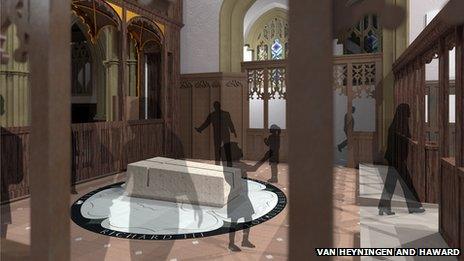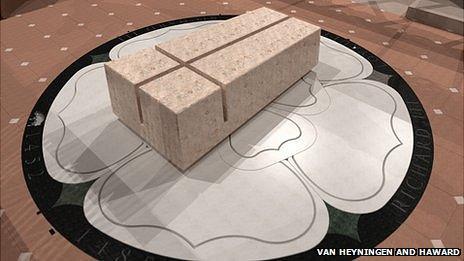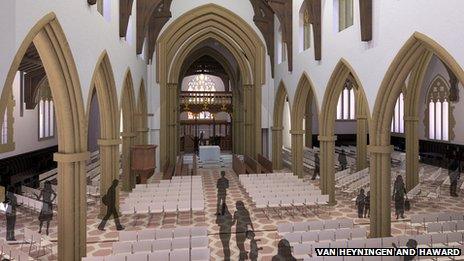Richard III tomb new design revealed by Leicester cathedral
- Published

The £1.3m project will see an extensive remodelling of the cathedral and gardens

The limestone tomb is tilted slightly to the east as a symbol of resurrection

Officials said they wanted the building to remain a place of community worship
A new design for Richard III's tomb has been revealed by Leicester Cathedral.
Plans for the raised tomb with a deeply carved cross, on a floor inlaid with a large Yorkist white rose, will now be submitted to planning officials.
Set within the cathedral's chancel, the £1.3m project, external will also see changes to internal layout, windows and lighting.
A legal challenge has put the tomb's location in doubt but cathedral officials said this was the "right place and the best place".
The remains of the king, who died in battle in 1485, were discovered by archaeologists under a Leicester car park in September.
Church authorities had originally favoured a flat slab to mark the tomb but changed their plans in the face of strong feedback.
Preparatory work has already begun, with test pits being dug in the building's floor.
However the process has been complicated by a legal challenge from a group of distant relatives of the king, who call themselves the Plantagenet Alliance.
They want to see the remains placed in York, where Richard had strong links, and last month won a judicial review of the licence that says he should go to Leicester.
The Ministry of Justice has indicated it intends to contest the decision to allow the review.
But Leicester cathedral officials said they were obliged to press on with the tomb plans which they describe as "regal and respectful in its elegant simplicity".
Canon Pete Hobson said: "We are very confident the grounds for issuing the licence were correct but we also had no choice - we have been asked by a proper request to go ahead.
Leicester Cathedral has unveiled its plans for a tomb to hold the remains of King Richard III.
"It takes this planning, because despite the speculation nobody else in the country is actually planning for it, and it takes the amount of time and energy and money we have had to put into it.
"So, yes, there is a small element of risk because some people have other ideas about where he should go but we believe this is not only the right place but the best place."
The Richard III Society, which was closely involved in the dig to find the bones, had campaigned strongly for a raised tomb.
Its chairman, Dr Phil Stone, said: "I think it is inspired. I was surprised at the depth of the cross but have been reassured by the thinking behind it.
"And the overall design of the space, with the detailed rose, is beautiful.
"I sincerely hope this design is approved or, should Richard's remains go elsewhere, will very much inform those who plan another tomb."
The cathedral's proposals will now go before the Cathedrals Fabric Commission for England, a national planning body, with a final decision expected in late October.
A reinterment ceremony was due to take place in May 2014 but this had been put in doubt by the court case.